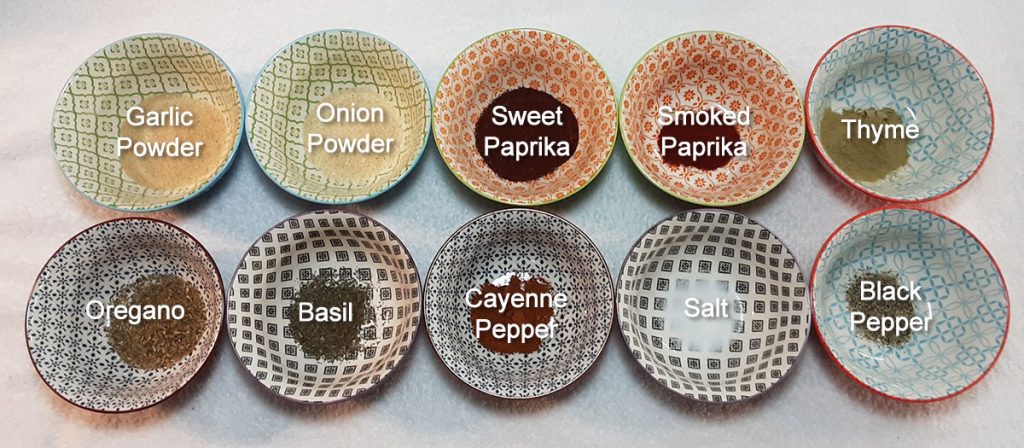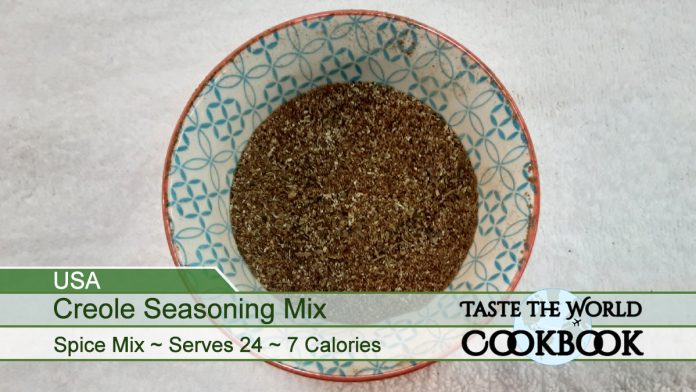Embracing the vibrant essence of Baton Rouge, Louisiana, our Creole Seasoning Mix is more than just a spice blend; it is a culinary experience. This versatile concoction promises to take a permanent place in your spice cabinet, reinventing the ordinary with its distinctive flavor profile.
Drawing on the rich and diverse cultural melting pot of Louisiana, this Creole Seasoning Mix is expertly crafted to bring out the best in your dishes. Each ingredient combines to create a symphony of flavors, embracing the sweet, the savory, and the spicy. Just a pinch of this seasoning mix can bring any meal from mundane to magical, transcending borders and inviting your palate to embark on a flavor-packed adventure.
This Creole Seasoning Mix is the result of centuries of culinary refinement, transforming staple spices into a unique blend. It embodies the Creole tradition, capturing the spirit and verve of Louisiana in a bottle. Whether you are a seasoned chef or an enthusiastic amateur, this seasoning blend is an essential part of your culinary journey.
Table of contents
The Multifaceted Applications of Creole Seasoning Mix
The Creole Seasoning Mix is not just a spice but an essential component that magnifies the flavor of a myriad of dishes. From classic Louisiana specialties like gumbo and jambalaya to seafood delights such as shrimp, crawfish, and crab boils, this seasoning adds a robust flavor that elevates the dish.
The versatility of this mix extends beyond traditional dishes; it breathes new life into seasoned rice, soups, stews, salads, and even eggs. Grilled meats, poultry, and seafood turn into gourmet meals with a touch of this Creole spice. It also adds a savory twist to pasta salads and potato salads and provides a zesty kick when sprinkled on French fries and potatoes. It makes popcorn more exciting and can even be used as a dry rub or incorporated into vinaigrette for a punchy dressing.
No dish is too ordinary for the Creole Seasoning Mix. With it, every meal becomes a flavorful exploration, invigorating your senses and bringing a taste of Louisiana to your table. No matter where you are, it’s like having a little piece of Creole culture in your kitchen.
Effective Preservation of Creole Seasoning Mix
To maintain the potent flavors of the Creole Seasoning Mix, it should be stored in an airtight spice jar, tucked away in a cool, dark corner of your kitchen or spice pantry. Ground spices, being the core of this mix, are susceptible to losing their freshness over time, typically not exceeding a six-month shelf life.
To ensure your spices remain fresh, you need to adopt a sensory approach. The freshness of ground spices can be determined by their aroma. If you open the jar and the smell isn’t as vibrant as it once was or is completely absent, it’s time to refresh your stock. As the sensory strength of the spice is integral to the flavor it imparts, keeping it fresh ensures your dishes continue to have that authentic Creole kick.
Preservation is key to maintaining the unique taste this Creole Seasoning Mix provides. So, handle it with care and it will reward you with a consistently potent flavor, elevating each dish you create to a new culinary dimension.
The Rich Legacy of Creole Seasoning
Creole Seasoning, an iconic culinary creation, is widely attributed to Tony Chachere, an esteemed American chef. Known for founding Tony Chachere’s Creole Foods, Seasonings, and Ingredients brand, his original product, Tony Chachere’s Original Creole Seasoning, is still celebrated today.
Chachere’s contribution is more than just a seasoning; it’s a tangible manifestation of the vibrant Creole culture. His seasoning mix, an innovative fusion of flavors, set the culinary world ablaze, redefining the meaning of Creole cuisine. Each bottle of Tony Chachere’s Original Creole Seasoning symbolizes a tradition steeped in diversity and innovation.
However, the history of Creole seasoning is not just about one man’s invention but the culmination of an entire culture’s culinary evolution. Infused with the influences of French, Spanish, African, and Native American cuisines, Creole seasoning is a testament to Louisiana’s rich cultural tapestry. Each spice in the blend tells a story of the region, its people, and their passion for food.
Discovering Baton Rouge, Louisiana: A Metropolitan Jewel on the Mississippi
Poised on the Mississippi River, Baton Rouge, the capital city of Louisiana, proudly showcases its historical and contemporary charm. Among its captivating landmarks from the antebellum period, the castle-like Old Louisiana State Capitol stands out, now functioning as a museum. The Magnolia Mound Plantation is another exquisite relic, boasting a French Creole house that provides an authentic glimpse into the region’s past.





Adding to its historic richness, the LSU Rural Life Museum, an assembly of beautifully refurbished structures, paints a vivid picture of life in the 18th and 19th centuries. Anchored on the river, the USS Kidd, a retired WWII destroyer, serves as a remarkable museum, narrating stories of bravery and resilience. Indeed, Baton Rouge, with its fusion of history and modernity, offers an intriguing exploration of American culture and heritage.
As a metropolitan hub, Baton Rouge buzzes with an effervescent lifestyle. Its thriving arts scene, diverse culinary offerings, and a myriad of entertainment venues make it a lively destination for locals and tourists alike. In Baton Rouge, one can truly experience the warmth of Southern hospitality and the pulsating rhythm of a vibrant city.
Baton Rouge, Louisiana: Tracing the Historical Footprints
Archaeological evidence reveals human habitation in the Baton Rouge area dating back to 12000–6500 BC, highlighting the city’s ancient roots. Traces of these early settlers can be found along the Mississippi, Comite, and Amite rivers, serving as silent testimonials to the region’s prehistoric past.
Baton Rouge’s history took a notable turn in 1698, under the French explorer Pierre Le Moyne d’Iberville. On his Mississippi River expedition, d’Iberville and his team noticed a red pole demarcating the hunting grounds between the Houma and Bayagoula tribes. This led to the naming of the city as le bâton rouge (“the red stick”), a translation of the native term Istrouma, believed to be derived from the Choctaw phrase iti humma (“red pole”). The first comprehensive account of this expedition was published by André-Joseph Pénicaut, a carpenter accompanying d’Iberville, in 1723.
Furthermore, the history of Baton Rouge is intrinsically tied to the Creole ethnic group, originating from racial amalgamation mainly involving West Africans, French, Spanish, and Indigenous American peoples during the colonial era. This process, known as creolization, resulted in a wide variety of ethnic backgrounds and mixtures, leading to the emergence of distinct Creole identities. Interestingly, the development of Creole languages is often erroneously linked to the emergence of these identities; however, the two phenomena occur independently.
Unveiling Baton Rouge, Louisiana: A Treasure Trove for Tourists
Baton Rouge entices visitors with its architectural masterpieces, ranging from the antebellum era to modern times. One such landmark is the neo-gothic Old Louisiana State Capitol, erected in the 1850s as Baton Rouge’s first statehouse. Later, the New Louisiana State Capitol, a towering 450-ft-tall art-deco edifice, replaced it. Notably, upon completion, it held the distinction of being the tallest building in the South.
In addition to these political landmarks, several plantation homes in the region, including the Magnolia Mound Plantation House, Myrtles Plantation, and Nottoway Plantation, beautifully display antebellum-era architecture. These exquisite structures serve as timeless symbols of the city’s rich history, adding to Baton Rouge’s appeal as a tourist hotspot.
Cajun Cuisine: A Flavorful Journey into Louisiana’s Culinary Heritage
Cajun cuisine is a unique culinary style that emerged from the Cajun–Acadians, who were displaced from Acadia to Louisiana during the 18th century. This gastronomic tradition embodies a medley of West African, French, and Spanish cooking techniques, reflecting the region’s diverse cultural influences.
Often referred to as a ‘rustic cuisine’, Cajun cuisine primarily relies on locally sourced ingredients and boasts simple yet flavorful preparations. This style of cooking is a testament to the region’s agricultural abundance and the local community’s ingenuity in creating delectable dishes using the resources available to them.
An authentic Cajun meal typically involves a three-pot affair: one pot dedicated to the main dish, another to steamed rice, sausages, or a seafood dish, and the third brimming with fresh, seasonal vegetables. Staple meats, such as crawfish, shrimp, and andouille sausage, feature prominently in a variety of Cajun dishes, lending a unique flavor profile to this beloved culinary tradition.
– Featured Grocery Store –
Matherne’s Market
440 N 3rd St, Baton Rouge, LA 70802
Matherne’s Market is a family-owned business that has been serving the River Parish and Baton Rouge communities for over 35 years. Our company, which started as a convenience store in Grand Point, LA, has grown to four locations that offer an extensive selection of local and international products, fine wines and craft beers, and authentic Louisiana-style prepared meals. We believe in providing our communities with clean stores, friendly service, and a fast and convenient shopping experience!
Crafting Your Own Creole Seasoning Mix: A Quick Guide
Creating your own Creole seasoning mix can be an effortless and enjoyable endeavor. The necessary ingredients are readily accessible and can easily be found in local supermarkets. To get started, all you need is a clean spice jar for storing your homemade mix.
To craft this flavorful blend, combine a variety of spices, such as paprika, cayenne pepper, garlic powder, onion powder, salt, and pepper, among others. Thoroughly mix these ingredients and then store your homemade Creole seasoning in the prepared spice jar. Always keep this mix in a cool, dark area of your kitchen, preferably your spice pantry, to maintain its freshness.
With this simple recipe, you can add a burst of Creole flavor to any dish, whether it’s a classic gumbo, jambalaya, or even a humble serving of grilled vegetables. Dive into the culinary world of Louisiana and let your taste buds experience the magic of homemade Creole seasoning.
Gathering Your Essentials: The First Step to Creating Creole Seasoning Mix
Before embarking on your culinary journey to craft a delicious Creole Seasoning Mix, it is essential to prepare and lay out all necessary ingredients and equipment. This preliminary step not only ensures that you have everything you need at your fingertips but also streamlines the entire process. Gather your selection of spices that encapsulate the essence of Creole cuisine. Also, have your measuring spoons, a mixing bowl, and a clean spice jar ready for use. Organizing your workspace in this way sets the stage for a successful and enjoyable cooking experience.

Equipment Needed
- 1 Mixing Bowl
- 1 Spice Jar
Ingredients Needed
- 4 teaspoons garlic powder
- 4 teaspoons onion powder
- 2 tablespoons sweet paprika powder
- 1 teaspoon smoked paprika
- 1 tablespoon dried thyme
- 2 teaspoons dried oregano
- 2 teaspoons dried basil
- 2 teaspoons cayenne pepper (or less if you don’t want it as hot)
- 1½ teaspoons salt
- 1 teaspoon freshly ground black pepper
Time needed: 5 minutes
How to Mix Creole Seasoning
- Mix
Place all of the spices in a mixing bowl and mix well.
- Store
Store in an airtight jar until ready to use.
If you liked this dish please Rate This Recipe and leave a comment.
Homemade Creole Seasoning
Please Rate this Recipe
Ingredients
- 4 tsp garlic powder
- 4 tsp onion powder
- 2 tbsp sweet paprika
- 1 tsp smoked paprika
- 1 tbsp dried thyme
- 2 tsp dried oregano
- 2 tsp basil
- 2 tsp cayenne pepper (or less if you don’t want it as hot)
- 1½ tsp salt
- 1 tsp black pepper
Instructions
- Place all of the spices in a mixing bowl and mix well.4 tsp garlic powder, 4 tsp onion powder, 2 tbsp sweet paprika, 1 tsp smoked paprika, 1 tbsp dried thyme, 2 tsp dried oregano, 2 tsp basil, 2 tsp cayenne pepper, 1½ tsp salt, 1 tsp black pepper
- Store in an airtight jar until ready to use.
Notes
Nutrition
Discovering the Culinary Wonders: Recipes Enhanced with Creole Seasoning Mix
As you explore the culinary landscape with your newly crafted Creole Seasoning Mix, it’s time to introduce it to a range of diverse recipes. This versatile seasoning doesn’t just add a kick to your classic Louisiana dishes like Gumbo and Jambalaya, but it also enhances the flavors of everyday recipes, creating a fusion of taste that’s uniquely satisfying. Whether it’s a humble vegetable stir-fry or an elaborate seafood pasta, the addition of this Creole mix can elevate your dishes, offering a taste adventure that goes beyond the conventional. So let’s dive into some handpicked recipes that are wonderfully complemented by this versatile Creole Seasoning Mix.
- Gumbo
- Jambalaya
- Shrimp, Crawfish, or Crab Boil
- Seasoned Rice
- Soups
- Stews
- Salads
- Burgers
- Eggs
- Marinade
- Grilled Meats, Poultry, and Seafood
- Pasta Salads
- Potato Salads
- Sprinkled on French Fries and Potatoes
- Popcorn
- Dry Rub
- Vegetables
- Whisked into your Vinaigrette for a Zesty Dressing
- …and on anything else that needs a flavor boost!
As we wrap up our flavorful journey with the Creole Seasoning Mix, it’s clear how this versatile blend can be a game-changer in your culinary adventures. By infusing a medley of flavors into your everyday dishes, you can bring the rich, diverse taste of Louisiana right into your home. Whether it’s enhancing the depth of a classic dish or adding an unexpected twist to a family favorite, this homemade Creole seasoning is your secret ingredient to creating meals that are simply unforgettable. So continue to experiment and discover more delightful ways to incorporate this flavorful blend into your culinary repertoire. Happy cooking!
Photo Credits:
- By Taste The World Cookbook – Copyright 2022 All rights reserved.
- By Matherne’s Market – Copyright BY https://www.facebook.com/matherneslongview/
- By getmahesh – https://www.flickr.com/photos/getmahesh/8674772313/in/photolist-bCideq-6Z6kYd-bCibWE-fb9dDs-edJgES-edJgj5-6Z6myf-6Z6kby-9J4Bh6-asxEPy-6Z2k7c-6Z2ifk-6Z6jmA-7akw8q-6Z2jPR-6Z6nFm-6Z6wys-6Z6wk5-asuZcp-o2cWv-6ppuS4-bRcWNa-edytzT-bQb6ZT-bQbiQp-bQbd1P-bBgx8o-bBgweN-bQbpRr-bQbhqi-bQbqFB-bQbgpz-bBgCFw-bQbsRK-bQbr5B-bBgAx9-bBgF7E-bBgVW3-bBguAy-nFNi1-bQbkUV-bBgRFJ-bBgtdW-bBgGGb-bBgSy9-bBgsVL-bBgRc9-bQbbmi-bRcWsK-bQbuXT, CC BY-SA 2.0, https://commons.wikimedia.org/w/index.php?curid=77487643
- By Yousef Abdul-Husain – Own work, CC BY-SA 4.0, https://commons.wikimedia.org/w/index.php?curid=45577427
- By user:Cmire4 – Own work, CC BY-SA 3.0, https://commons.wikimedia.org/w/index.php?curid=1799618
- By Farragutful – Own work, CC BY-SA 3.0, https://commons.wikimedia.org/w/index.php?curid=33337102
- By davidpinter, CC BY 3.0, https://commons.wikimedia.org/w/index.php?curid=57607843


